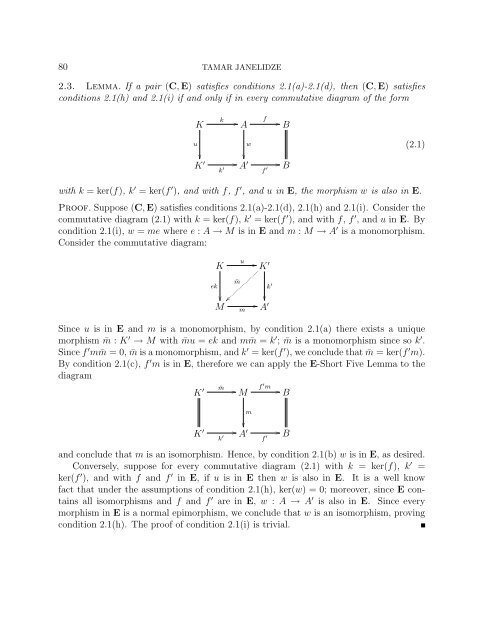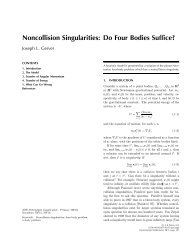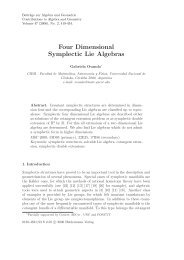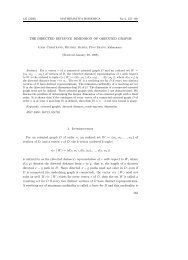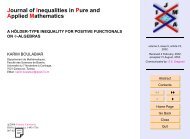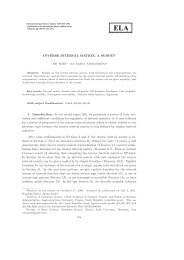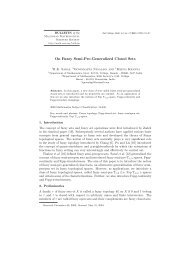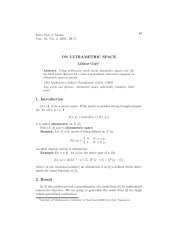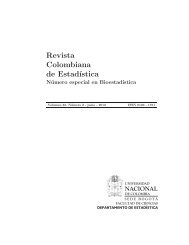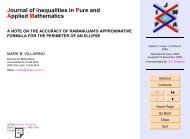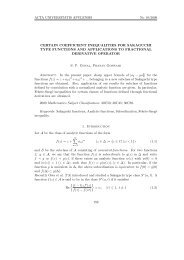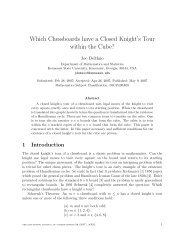SNAKE LEMMA IN INCOMPLETE RELATIVE HOMOLOGICAL ...
SNAKE LEMMA IN INCOMPLETE RELATIVE HOMOLOGICAL ...
SNAKE LEMMA IN INCOMPLETE RELATIVE HOMOLOGICAL ...
You also want an ePaper? Increase the reach of your titles
YUMPU automatically turns print PDFs into web optimized ePapers that Google loves.
80 TAMAR JANELIDZE<br />
2.3. Lemma. If a pair (C, E) satisfies conditions 2.1(a)-2.1(d), then (C, E) satisfies<br />
conditions 2.1(h) and 2.1(i) if and only if in every commutative diagram of the form<br />
K<br />
k<br />
A<br />
f<br />
B<br />
u<br />
w<br />
K ′ k ′ A ′ f ′ B<br />
(2.1)<br />
with k = ker(f), k ′ = ker(f ′ ), and with f, f ′ , and u in E, the morphism w is also in E.<br />
Proof. Suppose (C, E) satisfies conditions 2.1(a)-2.1(d), 2.1(h) and 2.1(i). Consider the<br />
commutative diagram (2.1) with k = ker(f), k ′ = ker(f ′ ), and with f, f ′ , and u in E. By<br />
condition 2.1(i), w = me where e : A → M is in E and m : M → A ′ is a monomorphism.<br />
Consider the commutative diagram:<br />
K<br />
u K ′<br />
ek<br />
¯m<br />
M m<br />
A ′<br />
Since u is in E and m is a monomorphism, by condition 2.1(a) there exists a unique<br />
morphism ¯m : K ′ → M with ¯mu = ek and m ¯m = k ′ ; ¯m is a monomorphism since so k ′ .<br />
Since f ′ m ¯m = 0, ¯m is a monomorphism, and k ′ = ker(f ′ ), we conclude that ¯m = ker(f ′ m).<br />
By condition 2.1(c), f ′ m is in E, therefore we can apply the E-Short Five Lemma to the<br />
diagram<br />
K ′ ¯m M<br />
m<br />
k ′<br />
f ′ m<br />
B<br />
K ′ k ′ A ′ f ′ B<br />
and conclude that m is an isomorphism. Hence, by condition 2.1(b) w is in E, as desired.<br />
Conversely, suppose for every commutative diagram (2.1) with k = ker(f), k ′ =<br />
ker(f ′ ), and with f and f ′ in E, if u is in E then w is also in E. It is a well know<br />
fact that under the assumptions of condition 2.1(h), ker(w) = 0; moreover, since E contains<br />
all isomorphisms and f and f ′ are in E, w : A → A ′ is also in E. Since every<br />
morphism in E is a normal epimorphism, we conclude that w is an isomorphism, proving<br />
condition 2.1(h). The proof of condition 2.1(i) is trivial.


